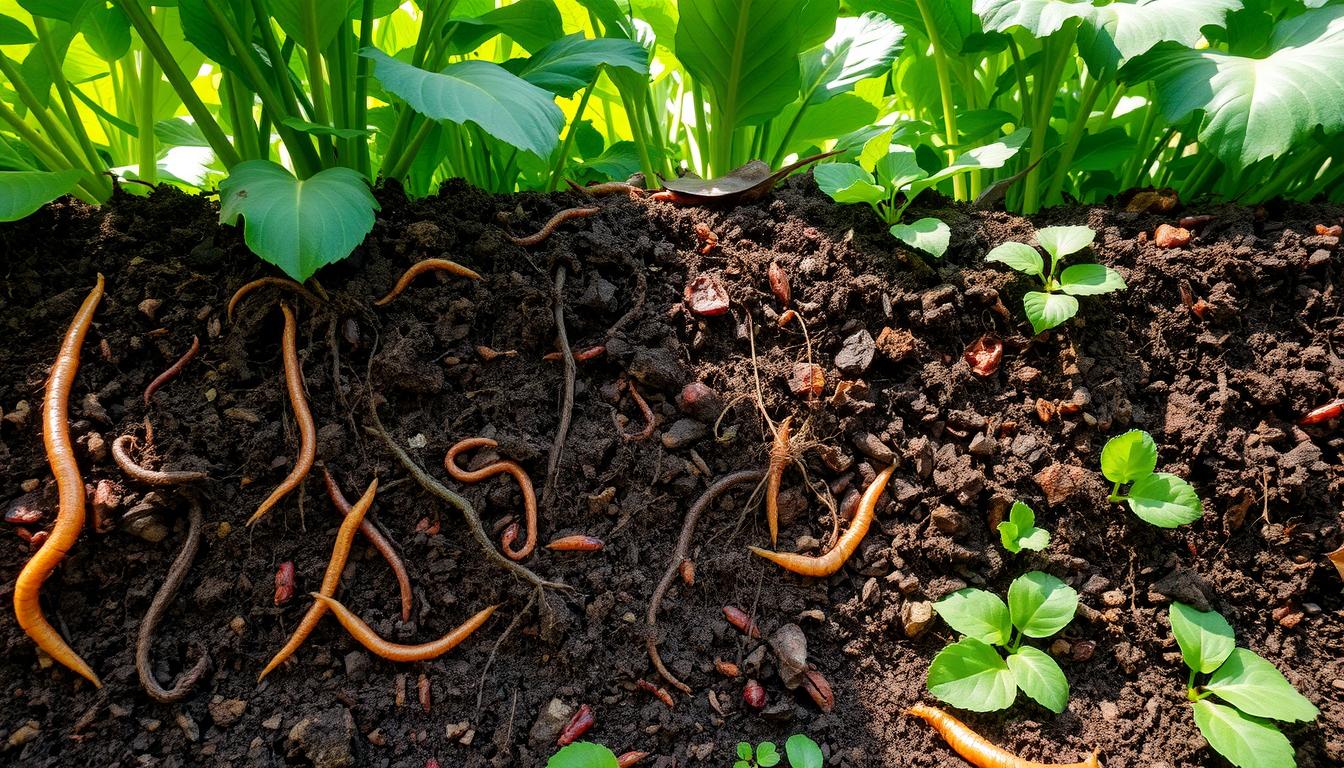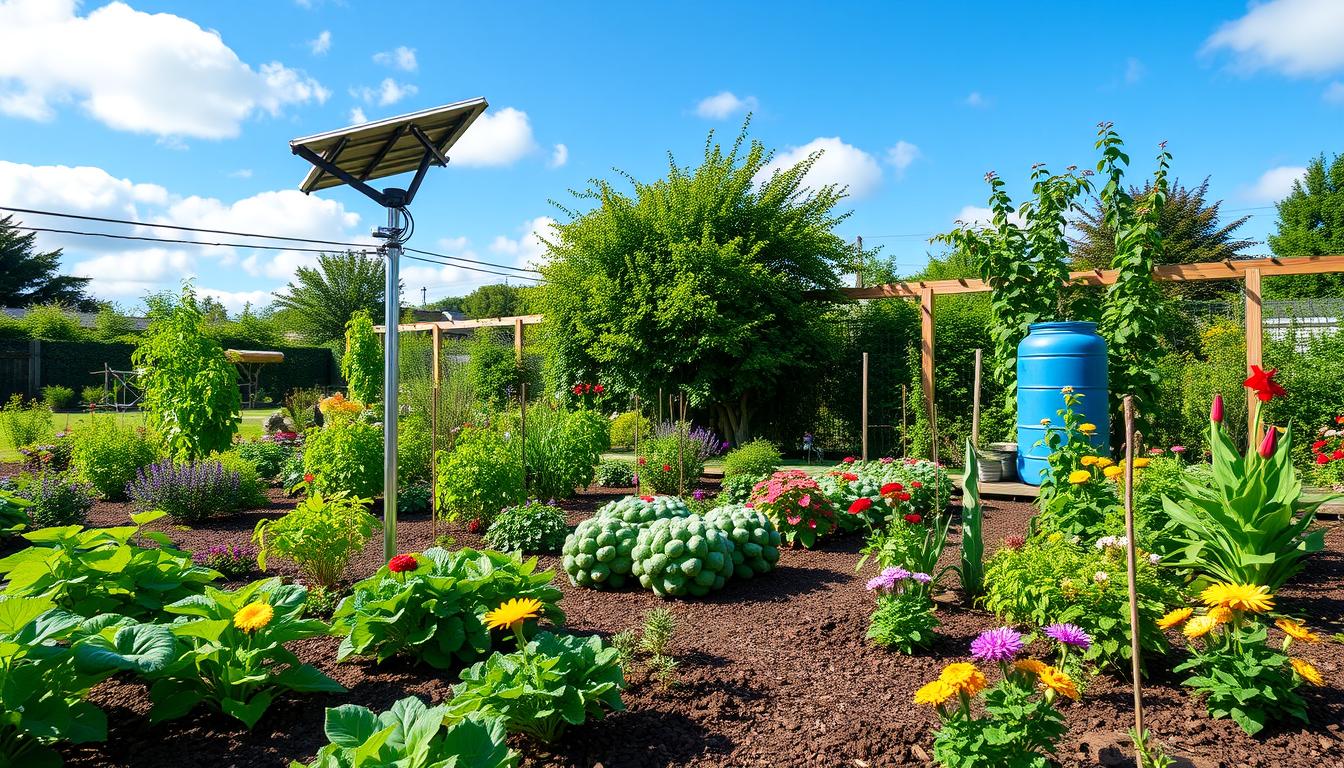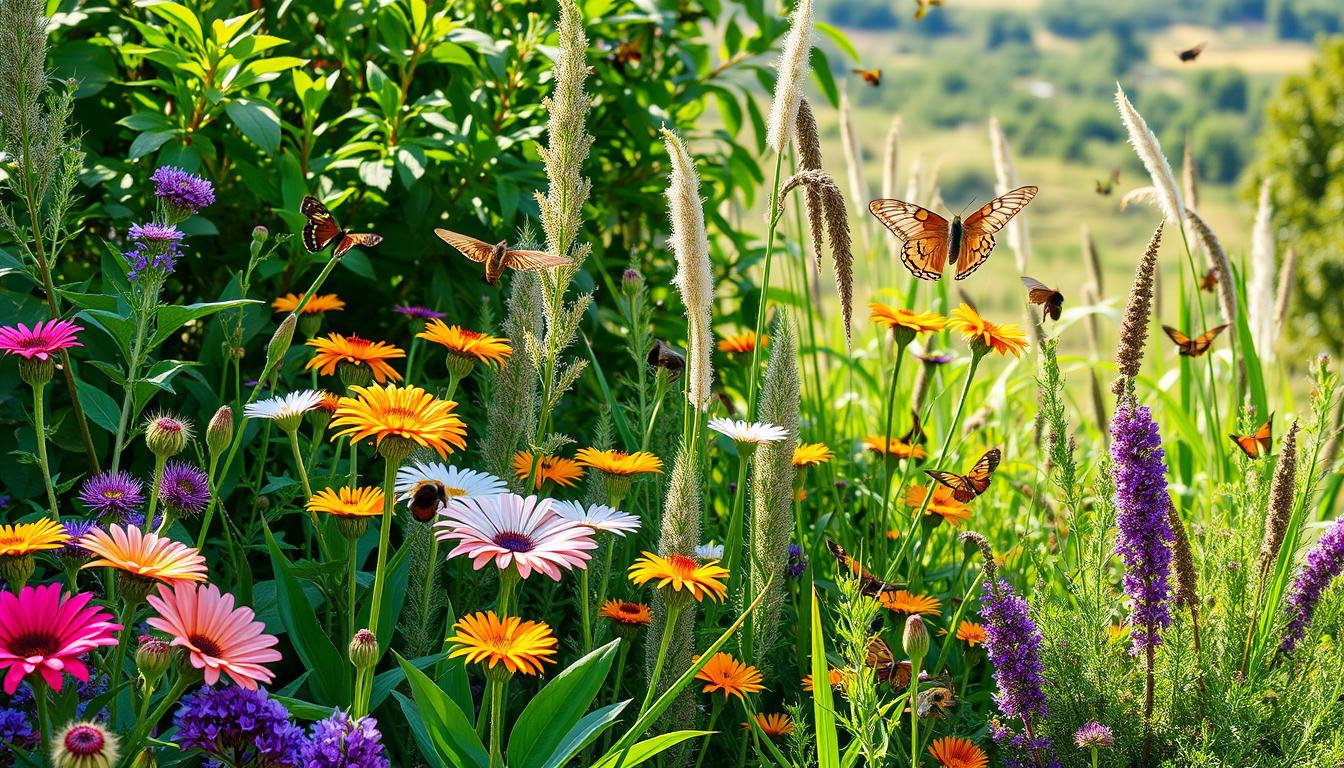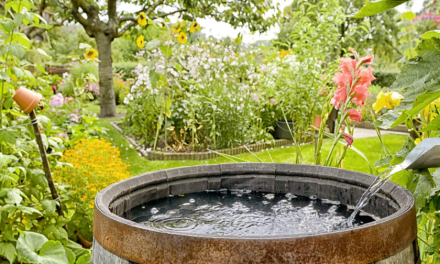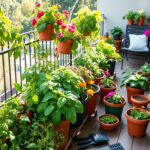Did you know that 90% of native plant species support local wildlife? This turns gardens into vibrant ecosystems. The sustainable garden guide helps you create an eco-friendly landscape that feeds your garden and your body.
Organic gardening is more than just growing veggies. It’s a way to grow food that respects the environment, cuts down on carbon footprint, and boosts biodiversity. Following sustainable gardening can make your outdoor space a thriving, productive place.
To succeed in eco-friendly landscaping, you need to know your local environment. Choose the right plants and use clever gardening techniques. Whether you have a big backyard or a small balcony, there are sustainable methods for every space.
Key Takeaways
- Native plants support local wildlife and enhance garden biodiversity.
- Sustainable gardening reduces environmental impact.
- Organic methods minimize chemical interventions.
- Small spaces can be productive through creative gardening techniques.
- Climate-conscious gardening helps mitigate environmental challenges.
Understanding Your Garden Space and Planning
Sustainable gardening begins with careful observation and planning. Knowing your garden’s unique traits and possibilities is key. With permaculture, even small areas can become productive.
Start by assessing your garden environment. Sunlight is vital for plant growth. Most fruiting veggies need 6-8 hours of direct sunlight daily.
Evaluating Sunlight and Soil Conditions
Soil health starts with soil testing. Knowing your soil’s makeup helps choose the right plants and amendments.
- Perform a soil pH test to determine nutrient levels.
- Check drainage capabilities of your garden area.
- Identify microclimates in your space.
Assessing Available Space and Layout Options
Gardens vary in size. Urban gardeners can use vertical gardening and containers to make the most of small spaces.
Space Type and Potential Growing Options Chart:
| Space Type | Potential Growing Options |
| Small Balcony | Herbs, compact vegetables, trailing plants. |
| Backyard | Raised beds, mixed vegetable gardens. |
| Rooftop | Container gardens, lightweight growing systems. |
Setting Realistic Gardening Goals
Setting achievable goals is key to gardening success. Think about your time, physical ability, and resources when planning.
- Begin with 2-3 easy-to-grow plants.
- Invest in quality tools and basic supplies.
- Create a flexible planting schedule.
Experts said,
Start small, learn continuously, and grow your garden alongside your skills.
Pro Tip: Start with small spaces to build confidence. Your garden is a journey of learning and adaptation.
Essential Soil Health Strategies for Organic Growth
Starting a thriving garden begins with understanding the soil beneath your feet. Soil health is key for organic gardening. It’s full of billions of microorganisms that help plants grow.
Soil Health Strategies For Organic Gardening
Transforming your soil health is all about a few essential steps that can turn your garden into a lush paradise. Let’s explore these key practices for vibrant plant life!
Here are some important techniques to enhance your garden’s foundation:
- Incorporate organic compost to boost nutrient content.
- Practice crop rotation to maintain soil vitality.
- Use natural mulching techniques.
- Conduct regular soil testing.
Organic gardening experts say,
Healthy soil is the cornerstone of a productive garden ecosystem.
Composting is vital for soil health. Adding highly decomposed organic matter creates humus. Humus is a stable nutrient source that helps plants grow.
Nutrient type, source and importance chart:
| Nutrient Type | Source | Importance |
| Macronutrients | Nitrogen, Phosphorus, Potassium | Essential for plant development. |
| Micronutrients | Iron, Zinc, Manganese | Critical for cellular functions. |
Knowing your soil’s makeup is important for gardening. The best soil is a mix of sand, silt, and clay. This mix helps roots grow and absorb nutrients well. Soil health strategies vary for each garden. Every garden needs a unique plan based on its ecosystem, plants, and local conditions.
Sustainable Garden Guide: Water Conservation Methods
Water conservation is key in eco-friendly landscaping. Gardeners help protect our most precious resource by using smart water strategies. By using water-saving methods, you can have a lush garden without wasting water.
Water Conservation In Garden
Sustainable gardening means managing water wisely. Studies show that smart gardens use less water and help local ecosystems.
Efficient Irrigation Techniques
Unleash the power of new irrigation techniques to conserve water and create a thriving garden oasis! Embrace these innovative methods for a greener future.
Here are some effective strategies:
- Install drip irrigation systems that target plant roots directly.
- Use soaker hoses to minimize water loss through evaporation.
- Water plants early morning or late evening to reduce water waste.
Leonardo Da Vinci said,
Water is the driving force of all nature.
Rainwater Harvesting Systems
Rainwater collection is a green way to water your garden. Simple harvesting methods can cut down on municipal water use.
Harvesting Method, Water Savings and Installation Difficulty:
| Harvesting Method | Water Savings | Installation Difficulty |
| Rain Barrels | Up to 40% | Low |
| Underground Cisterns | Up to 70% | High |
| Rainwater Catchment Systems | Up to 90% | Medium |
Drought-Resistant Gardening Practices
Picking the right plants is vital for saving water. Drought-tolerant plants need little water and do well in tough spots.
- Choose native plant species adapted to local climate.
- Apply 2-3 inches of organic mulch to retain soil moisture.
- Group plants with similar water requirements together.
By using these water-saving tips, gardeners can make landscapes that are green and strong. These landscapes support the environment and look great.
Selecting and Starting Native Plants
Choosing native plants is key to sustainable gardening. These plants are great for both gardeners and local wildlife. They make your garden strong and need little care.
Native Plant Selection For Organic Gardening
Knowing about native plants changes how you garden. They grow well in their local conditions, needing little help. Local native plants use up to 50% less water than non-native plants. Ecological gardening expert said,
Native plants are nature’s perfect garden solution – they work with your local environment, not against it.
Here are tips for picking native plants:
- Use the USDA Plant Hardiness Zone Map to find local plants.
- Check your garden’s sunlight and soil.
- Pick a variety of native plants for a healthy garden.
- Think about the size and growth of the plants.
Good native plant gardening needs planning. Start seeds indoors to grow longer and better. Use different plants to make your garden like nature, with ground covers, shrubs, and perennials.
Organic gardening with native plants is easy. Most native plants don’t need much fertilizer and fight off pests well. By picking plants that fit your area, you’ll have a garden that’s healthy and green.
Natural Pest Management and Ecosystem Balance
Gardening success comes from a balanced ecosystem that controls pests naturally. Integrated pest management is a holistic way to keep gardens healthy without harmful chemicals. Most insects are important in garden ecosystems, not pests.
Natural Pest Management In Garden
Sustainable gardeners know that stopping pests before they start is better than treating them. Permaculture offers smart ways to keep a garden balanced and pest-free.
Beneficial Insects and Pollinators
A diverse garden ecosystem promotes the presence of beneficial insects that help manage pest populations.
The following are key strategies to achieve this:
- Plant a variety of flowering species to attract pollinators.
- Provide habitat for predatory insects like ladybugs and lacewings.
- Avoid broad-spectrum pesticides that harm beneficial insects.
Companion Planting Strategies
Companion planting is a powerful way to manage pests and improve garden health:
| Plant Combination | Pest Control Benefit |
| Marigolds with Tomatoes | Repels nematodes and attracts beneficial insects. |
| Basil near Peppers | Deters aphids and improves overall plant health. |
| Nasturtiums with Cucumbers | Attracts pollinators and repels cucumber beetles. |
Organic Pest Control Solutions
Effective organic pest control is more than just using natural chemicals. Physical barriers, natural predators, and cultural practices are key.
- Use row covers to protect vulnerable plants.
- Implement crop rotation to disrupt pest life cycles.
- Practice regular garden sanitation.
- Monitor plants frequently for early pest detection.
Experts say,
Working with nature, not against it, is the key to a healthy and productive garden.
By using these integrated pest management and permaculture techniques, gardeners can build strong ecosystems. These ecosystems naturally fight pests, support biodiversity, and keep plants healthy.
Composting and Organic Fertilization Methods
Turning kitchen scraps and garden waste into soil is key in organic gardening. Composting is a smart way to cut down on waste and help your garden grow. In the U.S., 28 percent of waste is food scraps and garden waste. Composting is a big step towards taking care of our planet.
Composting is like magic – turning waste into garden gold.
Healthy soil is the heart of a good garden. By using different composting methods, gardeners can make soil that plants love. This soil helps plants grow strong and healthy.
- Collect kitchen scraps like vegetable peels and coffee grounds.
- Balance green (nitrogen-rich) and brown (carbon-rich) materials.
- Maintain proper moisture and aeration in your compost pile.
- Use finished compost as a natural fertilizer.
There are many composting ways for every garden. For those with little space, vermicomposting with worms is a great choice. It turns waste into nutrient-rich soil quickly.
Composting method, time to completion and Nutrient Richness chart:
| Composting Method | Time To Completion | Nutrient Richness |
| Traditional Pile | 3-6 Months | High. |
| Vermicomposting | 2-3 Months | Very high. |
| Tumbler Composting | 1-3 Months | Moderate to high. |
Adding composting to your gardening routine helps the environment. It makes soil better and supports a healthy garden. Only 6 percent of food waste is composted in the U.S. If more people composted, we could make a big difference!
Space-Maximizing Techniques for Urban Gardens
Urban farming has changed how city folks garden. With less space, new ways to grow food in small areas have appeared. These methods are good for the planet and help people grow their own food.
Urban gardeners are getting creative with small spaces. They turn them into green areas that produce food. Creativity and smart design are essential to use every inch of space.
Vertical Gardening Solutions
Vertical gardening is a big help for city gardeners. It lets them use walls and ceilings for growing. This method is very popular among urban gardeners.
- Wall-mounted planters.
- Hanging basket systems.
- Trellises for climbing plants.
- Stackable garden towers.
Container Gardening Essentials
Container gardening is great for small urban spaces. It lets gardeners move plants around easily. Most gardeners choose containers that drain well and last long. Urban gardening expert said,
Small spaces can produce surprising abundance with the right approach to container gardening.
For good container gardening, consider these tips:
- Selecting well-insulated containers.
- Ensuring adequate drainage.
- Using high-quality potting mix.
- Choosing compact plant varieties.
Small Space Design Optimization
Urban farming needs smart planning to use small areas well. Creative designs can turn tiny spaces into gardens. Think about using herb spirals, window gardens, and small raised beds.
With smart planning and creative ideas, city folks can grow beautiful gardens. These gardens not only give fresh food but also make city living more attractive.
Seasonal Planning and Crop Rotation
For a sustainable garden to thrive, planning is key. Crop rotation is a vital permaculture method. It keeps your garden healthy and productive all year. Organic gardening expert said,
Crop rotation is not just a practice, it’s a garden’s natural defense system.
Smart gardeners know that rotating crops stops soil from getting worn out. It also fights pests. By changing where plants grow, you break disease cycles and keep soil nutrients balanced.
- Rotate vegetable families annually.
- Alternate heavy and light feeding crops.
- Plan for different root system depths.
- Consider nutrient requirements of each crop.
To do crop rotation right, you need to know about plant families. For example, nightshades should not stay in the same spot for at least four years. This stops diseases from building up.
Chart of plant family, rotation interval and key considerations:
| Plant Family | Rotation Interval | Key Considerations |
| Nightshades | 4 Years | Prevent disease buildup. |
| Brassicas | 3-4 Years | Manage soil nutrients. |
| Legumes | 2-3 Years | Nitrogen fixation. |
In small gardens, raised beds and containers help with crop rotation. Split your garden into parts. Move plant families around to keep soil healthy and pests away.
Permaculture is all about watching nature and adjusting. Keep track of your garden’s health. Note where you plant things. Change your plan based on what you see.
Eco-Friendly Garden Tools and Materials
Sustainable gardening is more than just picking plants. The tools and materials you use are key to a green garden. Choosing the right gear helps the planet and boosts your garden’s health.
Sustainable Equipment Choices
When making your green garden plan, pick tools that are kind to the earth.
Here are some eco-friendly picks:
- Hand tools made from recycled metals.
- Electric tools instead of gas ones.
- Tools made from bamboo, a renewable resource.
- Durable gardening tools that last long.
Sustainable gardening experts said,
Choose tools that work with nature, not against it.
Natural Mulching Options
Mulch does many good things for your garden. It keeps weeds down, holds in moisture, and makes your garden healthier.
- Straw and hay for garden beds.
- Wood chips for paths.
- Grass clippings as a nutrient-rich cover.
- Fallen leaves for natural breakdown.
Recycled Garden Materials
Make your garden green by using recycled stuff:
- Reclaimed wood for raised beds.
- Old containers as planters.
- Materials that let water through.
- Recycled plastic for edging.
Eco-friendly gardening is more than looks. It’s about making a garden that’s good for both you and the planet. By picking the right tools, mulch, and materials, you can create a green space that’s waste-free and supports natural growth.
Conclusion
Organic gardening is more than a hobby; it’s a way to care for our planet. Sustainable garden guides show how we can turn our outdoor spaces into thriving ecosystems. By using eco-friendly methods, we can help plants and animals in our area.
Creating a sustainable garden takes ongoing learning and careful actions. Using native plants can save up to 75% of water. Vertical gardening can also boost plant growth by 50%. These steps help save resources and support local wildlife.
Getting involved in the community makes gardening even more rewarding. Local gardening events can increase social connections by 40% and even lower crime rates. Sharing knowledge and resources helps build strong networks that spread sustainable living.
Your garden is a living, growing system that needs attention and creativity. Be open to trying new things, learn from both wins and losses, and know that every choice helps our planet. The future of gardening is bright, green, and full of possibilities.
Frequently Ask Questions (FAQ)
What is sustainable gardening?
Sustainable gardening is about growing food in a way that’s good for the planet. It uses natural methods and focuses on organic practices. This approach helps create a healthy garden ecosystem.
How much sunlight do I need for a successful sustainable garden?
Most plants need 6-8 hours of sunlight a day. Check how much sun your garden gets. Choose plants that fit the light conditions. For less sun, pick shade-tolerant veggies or use containers.
What are the best ways to improve soil health?
Improve soil by adding compost or aged manure. Use crop rotation and cover crops too. Avoid chemicals and test your soil often. Add organic stuff and no-till gardening to keep it healthy.
How can I conserve water in my garden?
Save water with drip irrigation or soaker hoses. Use rain barrels and pick drought-resistant plants. Mulch helps keep soil moist. Water deeply but not too often.
Why should I use native plants in my garden?
Native plants need less water and care. They help local wildlife and ecosystems. They also cut down on fertilizers and pesticides. Pick plants native to your area for the best results.
What are some natural pest management techniques?
Attract good bugs and use companion planting to keep pests away. Try organic pest control like handpicking or homemade sprays. A diverse garden is key to keeping pests in check.
How do I start composting?
Start a compost pile with kitchen and yard waste. Mix green and brown materials. Turn it often and keep it moist. Use the finished compost to feed your garden.
Can I create a sustainable garden in a small urban space?
Yes! Use vertical gardening and containers to make the most of small spaces. Try herb spirals or compact raised beds. Look into community gardens or rooftop spaces for more room.
What are the benefits of sustainable gardening?
Sustainable gardening gives you fresh, organic food and helps the environment. It boosts biodiversity and saves money. It also connects you to nature and improves soil health.
How do I get started with sustainable gardening?
Start by checking your space and soil. Pick plants that fit your climate. Begin with easy veggies or herbs. Learn about organic soil and pest control. Join local groups or take workshops to learn more.

